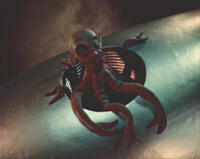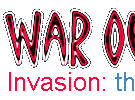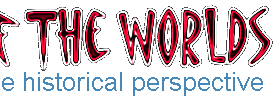War of the Worlds, Ray Harryhausen (1949)

Ray Harryhausen is world renowned as the master of stop motion animation,
the technique of bringing to life objects by making tiny movements in articulated
models and filming the changes one frame at time. His films include Earth V's
The Flying Saucers, The Clash of the Titans, and from the pen of H.G. Wells,
The First Men In The Moon. Less well known is the fact that he worked extensively
on an idea for a film of The War of the Worlds as early as 1942, predating the
George Pal film by over a decade.
Harryhausen was in the US Army when he first conceived the idea and wrote a
basic outline. The Orson Welles broadcast influenced his decision to relocate
the action to America, setting his version in and around New York city. Sensibly
enough for a film version, he also created a new character to replace Well's
nameless narrator. Called Randy Jordan, he was to be a newspaper reporter, and
would bear witness along with Professor Pierson to the destruction of such iconic
landmarks as The Brooklyn Bridge, The Holland Tunnel and (who could imagine
otherwise given the location), the Statue Of Liberty.
Harryhausen was fully intending to use the Martian tripod war machines as
envisaged by Wells, and despite the inherent difficulties of such an approach,
would very likely have succeeded given the flexibility of his stop motion techniques.
He did intend making a slight change, in that the hoods of his machines would have
spun (the top one way, the bottom the other) with the idea that this would have
provided their movement and balance a gyroscopic rationale. Clearly then he was
thinking very hard about making his film as realistic as possible to the audience,
and it is fair to say that this unfulfilled project is one of the great losses of
modern cinema.
There is tantalisingly one brief filmed scene that gives a taste of what the
world has lost. In order to drum up interest in the project, Harryhausen shot a
16mm test of a Martian emerging from its cylinder. The cylinder was made of
plaster and the Martian of a metal armature covered with moulded latex. It is
an extraordinary scene (see right hand column on this page for where to buy it)
though Harryhausen now thinks that his designs for the Martians would not have
proved very terrifying for audiences. I think he may be right, but had the
project proceeded I am sure they would have been suitably refined. In further
support of the project, Harryhausen drew a dozen beautiful charcoal sketches of
key scenes and a storyboard of a scene in which the hero fights a Martian in a
farmhouse.
He took all this material to a number of possible financiers including Jesse
Lasky Sr. Lasky was one of the founder members of the Academy of Motion Picture
Arts and Sciences and in 1913 had formed with Cecil B. DeMille the Jesse L. Lasky
Feature Play Company, which is credited with making the first full length
Hollywood movie. Lasky was also Vice President In Charge Of Production at
Paramount which his company had taken control of and was one of the key players
in the silent film era, but the 1932 depression saw his fortunes collapse, and
when Harryhausen took him the War of the Worlds, Lasky was working as an independent
producer. This gave him the ability to shop the concept around all the major studios,
but even Paramount, who owned the rights, expressed no interest, though as you will
see later in this article, there seems a very clear reason for this.
Harryhausen even wrote to Orson Welles, but never received a reply. In October
of 1950 he visited his friend Frank Capra, the renowned director of It's A Wonderful
Life, and in a wide ranging discussion the subject of George Pal's recent film
Destination Moon arose. This prompted Harryhausen to realise that Pal might be the
very person he needed. Pal was at Paramount, who owned the rights and had a solid
science fiction background, so seemed ideal.
In his account of what then happened, Harryhausen is magnanimous toward
Pal, which given the circumstances I think is rather forgiving of him. On visiting
Pal and armed with his material, the two had talked for several hours about the project,
with Pal asking how long he thought the project might take to animate. Pal indicated
that he had heard that Fox and RKO were working on the idea, but that if Harryhausen
would leave his material, he would try and interest the front office. A few days later,
Harryhausen discovered that Pal had already been negotiating with Paramount to make
the movie, so you have to wonder just how economical he had been with the truth in
their meeting. Pal admitted several weeks later to Harryhausen that he was working
on the project and dangled the prospect of making a film of Tom Thumb using Harryhausen's
techniques. You have to wonder if Pal was offering this as a sop while he continued
with The War of the Worlds. Pal did eventually make Tom Thumb, but without Harryhausen.
This then was the death knell of the Harryhausen War of the Worlds project, but
the material left behind shows that it may well have ranked alongside the greatest
science fiction movies of all time.
|
Buy
The Ray Harryhausen footage is one of the extra features on the George Pal War of the Worlds DVD.
Concept art from the proposed Ray Harryhausen War of the Worlds film is contained in this book.
See also in:
Film & TV
|
1953
The War of the Worlds by George Pal. The action relocates to cold war America, with the Martian war machines re-invented as sinister flying machines.
|
|
1975
War of the Worlds TV Series by George Pal. Who knew that George Pal once planned a television series spin off from his 1953 movie?
|
|
1988
War of the Worlds An intermittently impressive TV series about a second Martian invasion of Earth.
|
|





